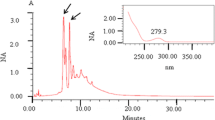Abstract
One hundred twenty three isolates ofP. chrysogenum were biologically tested in brine shrimp test and screened withStaphylococcus aureus for the detection of antibacterial activity. Furthermore, they were chemically examined (thin layer chromatographic method, TLC) for the synthesis of 8 mycotoxins (citrinin, cyclopiazonic acid, mycophenolic acid, patulin, penicillic acid, PR-toxin, ochratoxin A, and roquefortine). The results indicated that 85% of the tested isolates produce roquefortine and one isolate produces cyclopiazonic acid. Considering the results of the chemical assay for mycotoxins as well as the results of the brine shrimp test and the detection of antibacterial activity, 119 (97%) of the tested isolates are not suitable to be used as starter cultures for mould-fermented meats. The extracts of only 4 isolates were subjected to further biological tests in mice and the results indicated that only one isolate was non-toxinogenic.
Similar content being viewed by others
References
Leistner L, Eckardt C (1979) Vorkommen toxinogener Penicillien bei Fleisch-erzeugnissen. Fleisch Wirtschaft 59:1892–1896.
Leistner L, Hechelmann H, Trapper D (1980)Penicillium chrysogenum, eine Starterkultur für Rohwurst. Jahresber Bundesanst Fleischforsch Kulmbach C 22.
Leistner L, Eckardt C (1981) Schimmelpilze und Mykotoxine in Fleisch und Fleischerzeugnissen. In: Reiß J (ed), Mykotoxine in Lebensmitteln, Gustav Fischer Verlag, Stuttgart, p 333.
Leistner L, Linke H, Eckardt C, Lücke F-K, Hechelmann H (1979) Anforderungen an Starterkulturen. Abschlußbericht für ein vom Bundesminister für Jugend, Familie und Gesundheit unterstütztes Forschungsvorhaben, 108 Seiten.
Horwitz C, Wehner FC (1977) Antibiotics in mould-cured salami. S Afr Med J 52:669.
Leistner L, Pitt JI (1977) Miscellaneous penicillium toxins. In: Rodricks JV, Hesseltine CW, Mehlmann MA (eds), Mycotoxins in Human and Animal Health, Pathotox Publishers Inc, Park Forest South, II, pp 639–653.
Reiss J (1977) Mycotoxins in foodstuffs. X. Production of citrinin byPenicillium chrysogenum in bread. Food and Cosmetics Toxicol 15:303–307.
Cole RJ, Cox RH (1981) Handbook of Toxic Fungal Metabolites, Academic Press Inc, New York, p 520.
Frisvad JC (1984) Expressions of secondary metabolism as fundamental characters inPenicillium taxonomy. In: Kurata H, Ueno Y (eds) Developments in Food Science 7. Toxigenic Fungi — Their Toxins and Health Hazard. Kodansha Ltd, Tokyo and Elsevier Science Publishers, Amsterdam, pp 98–106.
Still P, Eckardt C, Leistner L (1978) Bildung von Cyclopiazonsäure durchPenicillium camemberti-Isolate von Käse. Fleischwirtsch 58:876–877.
Steyn PS (1969) The separation and detection of several mycotoxins by thinlayer chromatography. J Chromatog 45:471–473.
Pohland AE, Thorpe CW (1982) Mycotoxins. In: Bowman MC (ed), Handbook of Carcinogens and Hazardous Substances. Chemical and Trace Analysis, Marcel Dekker Inc, New York and Basel, pp 303–390.
Filtenborg O, Frisvad JC, Svendsen JA (1983) Simple screening method for molds producing intracellular mycotoxins in pure cultures. Appl Environ Microbiol 45:581–585.
Scott PM (1980) Analysis of mycotoxins other than aflatoxins in foodstuffs. In: Touchstone JC, Rogers D (eds) Thin Layer Chromatography: Quantitative Environmental and Clinical Applications, Wiley Interscience, New York, pp251–274.
Scott PM (1984) Roquefortine. In: Betina V (Ed) Developments in Food Science, 8. Mycotoxins. Production, Isolation, Separation and Purification. Elsevier Science Publishers, Amsterdam, pp 463–468.
Scott PM, Lawrence JW, van Walbeek W (1970) Detection of mycotoxins by thin-layer chromatography: application to screening of fungal extracts. Appl Microbiol 20:839–842.
Duracková Z, Betina V, Nemec P (1976) Systematic analysis of mycotoxins by thin-layer chromatography. J Chromatog 116:141–154.
Engel G, Teuber M (1984) Patulin and other small lactones. In: Betina V (Ed) Developments in Food Science, 8. Mycotoxins. Production, Isolation, Separation and Purification. Elsevier Science Publishers, Amsterdam, pp 291–314.
Harwig J, Scott PM (1971) Brine shrimp (Artemia salina L.) larvae as a screening system for fungal toxins. Appl Microbiol 21:1011–1016.
Frisvad JC, Filtenborg O (1983) Classification of terverticillate penicillia based on profiles of mycotoxins and other secondary metabolites. Appl Environ Microbiol 46:1301–1310.
Leistner L (1984) Toxigenic penicillia occurring in feeds and foods: a review. Food Technol in Australia 36:404–406,413.
Scott PM (1981) Toxins ofPenicillium species used in cheese manufacture. J Food Protection 44:702–710.
Leistner L (1986) Mould-ripened foods. Fleischwirtsch 66:1385–1388.
Author information
Authors and Affiliations
Rights and permissions
About this article
Cite this article
El-Banna, A.A., Fink-Gremmels, J. & Leistner, L. Investigation of Penicillium chrysogenum Isolates for their Suitability as Starter Cultures. Mycotox Res 3, 77–83 (1987). https://doi.org/10.1007/BF03191993
Received:
Accepted:
Issue Date:
DOI: https://doi.org/10.1007/BF03191993




